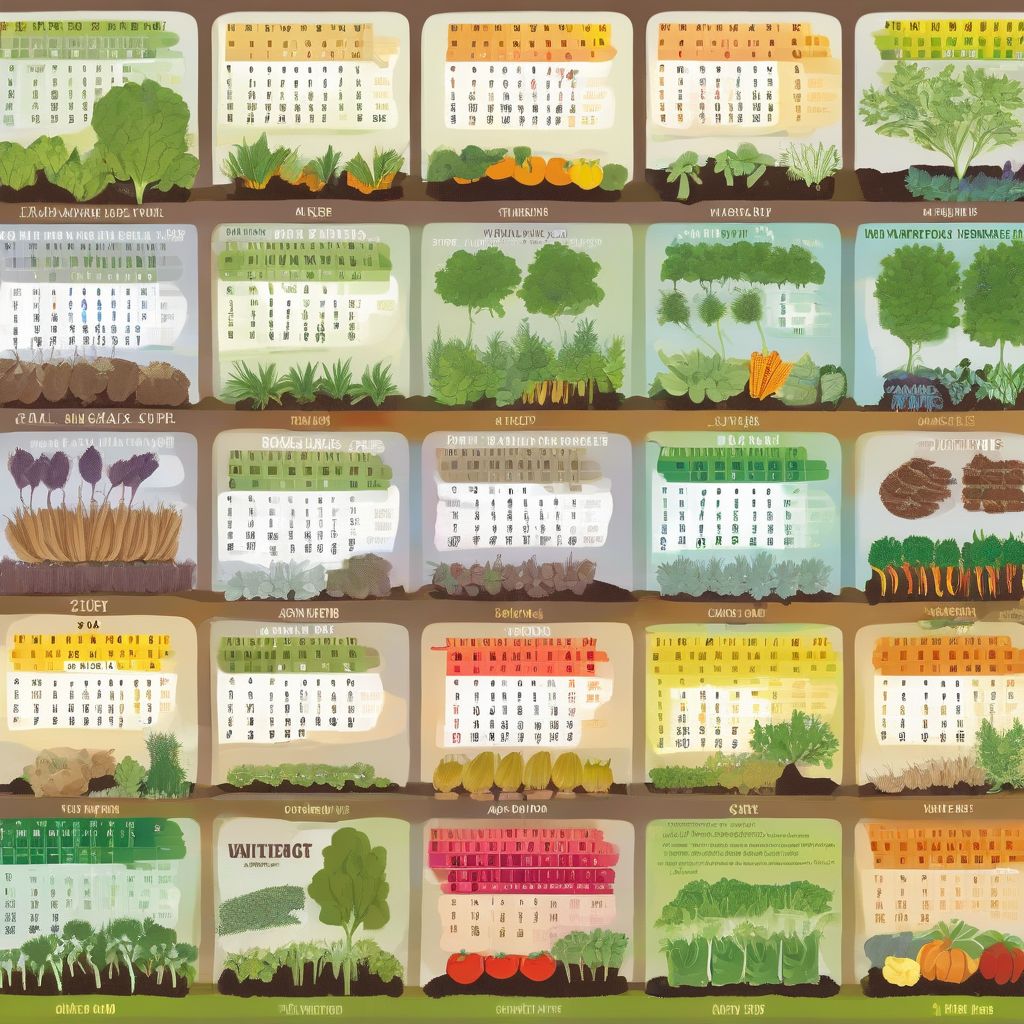“To plant a garden is to believe in tomorrow,” said Audrey Hepburn, and how true that is! There’s something magical about nurturing life from a tiny seed, watching it sprout, grow, and eventually yield delicious fruits, vegetables, or beautiful flowers. But to witness this wonderful transformation, you need to get the timing right. Planting seeds at the optimal time for your chosen crops and climate zone can make all the difference in the success of your garden.
This comprehensive guide will walk you through everything you need to know about finding the best time of year to plant different types of seeds, ensuring a thriving and bountiful garden.
Understanding the Basics of Seed Starting
Before we delve into specifics, let’s cover some essential knowledge about seed starting:
1. What is the Best Time to Plant Seeds?
The best time to plant seeds depends on several factors:
- Type of Plant: Different plants have different temperature and light requirements for germination and growth.
- Your Local Climate: Your geographical location dictates your last frost date in the spring and the first frost date in the fall, which bookend your growing season.
- Growing Season Length: Knowing how many frost-free days you have helps you choose suitable plant varieties and determine the best planting times.
2. Why is Timing So Important?
Planting too early or late can result in:
- Poor Germination: Cold soil can lead to seed rot, while extreme heat can dry out seeds, preventing germination.
- Stunted Growth: Young seedlings are vulnerable to frost and extreme temperatures, leading to stunted growth or plant death.
- Reduced Yields: Plants stressed by unfavorable weather conditions may produce fewer fruits, vegetables, or flowers.
3. Determining Your Hardiness Zone
Knowing your hardiness zone is crucial for successful gardening. This system, developed by the USDA, divides North America into 13 zones based on average minimum winter temperatures. Each zone represents a 10-degree Fahrenheit difference.
You can easily find your hardiness zone by entering your zip code on the USDA Plant Hardiness Zone Map website or consulting a local gardening guide.
Best Time to Plant Vegetables
Vegetables are broadly categorized into cool-season and warm-season crops based on their temperature preferences.
Cool-Season Vegetables
These hardy plants tolerate cooler temperatures and even light frosts.
Best Time to Plant:
- Early Spring: Start seeds indoors 4-6 weeks before the last expected frost or direct sow after the last frost.
- Late Summer/Early Fall: Many cool-season crops can be planted for a fall harvest.
Examples:
- Lettuce: Prefers cool weather, especially for optimal flavor.
- Spinach: A fast-growing cool-season green packed with nutrients.
- Peas: Enjoy the sweetness of fresh peas with an early spring planting.
- Radishes: These root vegetables thrive in cool temperatures and mature quickly.
Warm-Season Vegetables
These heat-loving plants thrive in warm soil and need plenty of sunshine.
Best Time to Plant:
- Late Spring/Early Summer: Direct sow seeds or transplant seedlings outdoors after the danger of frost has passed and the soil has warmed.
Examples:
- Tomatoes: Summer’s favorite fruit (yes, it’s a fruit!) requires warm temperatures for optimal growth.
- Peppers: Like tomatoes, peppers need plenty of heat and sunshine to produce their flavorful pods.
- Beans: Warm soil is crucial for bean seeds to germinate quickly and successfully.
- Cucumbers: These sprawling vines love warm weather and produce an abundance of refreshing cucumbers.
Best Time to Plant Fruits
Similar to vegetables, fruits also have specific temperature preferences for optimal growth and fruit production.
Cool-Season Fruits
These fruits prefer cooler temperatures, especially during their early stages of growth.
Best Time to Plant:
- Early Spring or Fall: Plant bare-root trees and shrubs while they are dormant.
Examples:
- Strawberries: Plant in early spring for a delicious summer harvest. Some varieties also produce a fall crop.
- Blueberries: These acid-loving shrubs prefer cool climates and well-drained soil.
- Raspberries: Plant in spring or fall, depending on the variety and your local climate.
Warm-Season Fruits
These fruits thrive in warm weather and need plenty of sunshine to ripen their fruits to perfection.
Best Time to Plant:
- Late Spring: After the danger of frost has passed and the soil has warmed.
Examples:
- Watermelons: These sprawling vines need plenty of space and sunshine to produce their juicy melons.
- Cantaloupes: Another type of melon that thrives in warm weather and well-drained soil.
- Figs: These heat-loving trees produce delicious, sweet fruits in late summer.
Best Time to Plant Flowers
Flowers bring vibrant colors and delightful fragrances to your garden. Understanding their planting times can help you enjoy beautiful blooms throughout the growing season.
Annual Flowers
These flowers complete their lifecycle in one growing season, providing a burst of color for a specific period.
Best Time to Plant:
- After the Last Frost: Direct sow seeds or transplant seedlings outdoors after the danger of frost has passed.
Examples:
- Zinnias: These easy-to-grow annuals come in a dazzling array of colors and attract pollinators.
- Sunflowers: Their cheerful faces follow the sun throughout the day, adding a touch of whimsy to the garden.
- Marigolds: Known for their vibrant orange and yellow hues, marigolds are also natural pest deterrents.
Perennial Flowers
These flowers return year after year, providing long-lasting beauty in your garden.
Best Time to Plant:
- Spring or Fall: Planting in spring allows them to establish themselves before the summer heat, while fall planting gives them time to develop roots before winter.
Examples:
- Lavender: Known for its soothing aroma and beautiful purple flowers, lavender is a favorite among pollinators.
- Coneflowers: These daisy-like flowers attract butterflies and come in a variety of colors, including purple, pink, and white.
- Black-Eyed Susans: Their cheerful golden flowers brighten up the late summer and fall garden.
 Planting Calendar
Planting Calendar
[amazon bestseller=”planting calendar”]
Tips for Successful Seed Starting
- Start with Quality Seeds: Choose fresh seeds from reputable suppliers to ensure good germination rates.
- Prepare Your Soil: Loose, well-drained soil is crucial for healthy root development. Amend your soil with compost or other organic matter to improve its texture and fertility.
- Provide Adequate Sunlight: Most vegetables and many flowers need at least 6 hours of direct sunlight daily. Choose a location in your garden that receives ample sun exposure.
- Water Consistently: Keep the soil evenly moist but not waterlogged. Water deeply and less frequently to encourage deep root growth.
- Protect from Pests and Diseases: Be vigilant about common garden pests and diseases that can damage your plants. Implement organic pest control methods and choose disease-resistant varieties whenever possible.
Conclusion
Timing is everything when it comes to planting seeds. By understanding the best time of year to sow seeds based on your local climate and the specific needs of your chosen plants, you can ensure a thriving and productive garden. Remember to start with quality seeds, prepare your soil properly, provide adequate sunlight and water, and protect your plants from pests and diseases. With a little care and attention, you’ll be rewarded with a bountiful harvest and the joy of nurturing life from tiny seeds.
Do you have any questions or tips for successful seed starting? Share them in the comments below. Happy gardening!
